CIO: IT Cost Management 101

The technology tide is here. Are you prepared to handle the cost tsunami?
In 2024, the unstoppable tide of workplace modernization and IT automation isn't just a trend - it's a business imperative. This movement, sweeping all corners of the corporate landscape, is ushering in an era synonymous with increased automation, pervasive adoption of cloud-based solutions, and the relentless drive for unique online customer experiences and optimized internal productivity.
What does this mean for the CIO? Businesses are now identifying as technology companies because they recognize the strategic necessity of such a shift. The result is an unprecedented increase in IT spending. According to a Gartner January 17, 2024 Press Release:
"Worldwide IT spending is expected to total $5 trillion in 2024, an increase of 6.8% from 2023, according to the latest forecast by Gartner, Inc. This is down from the previous quarter's forecast of 8% growth."
I also invite you to read the recently published CIO's "State of the CIO, 2023 Building Business Strategy. There has never been a more exciting and challenging opportune time for IT leaders to influence their company's strategy. But then again, I've been saying that for close to 40 years. It only gets better and harder.
What does it mean to the CEO?
Imagine standing at the core of a modern, cutting-edge business. As a CEO, you're aware of the pivotal role technology plays in being competitive and delivering exceptional products and services. You're convinced that strategic investments in IT could propel your business forward. However, you equally value prudence in spending habits and expect your CIOs and IT teams to stay on top of costs.
Does this tightrope walk sound familiar? The answer lies in IT cost management. Essentially, it aids you in strategically planning and controlling tech-related expenses, ensuring your investments pay off rather than tip the budget. It also frees up critical dollars to invest in new technologies.
What does it mean to the CIO?
Why is it critical? Well, in this fast-paced business environment, cost control is the backbone of organizational success, regardless of the industry. In support of the overall corporate cost management remit, CIOs are ever challenged to demonstrate business value while delivering greater services and value.
Level Setting Cost Management Vs Cost Control vs Cost Cutting?
We will start by ensuring a solid understanding of the difference between Cost Management, Cost Control, and Cost-cutting. There is an overlap and correlation.
Cost management is the process of planning and controlling the budget of a business, department of a project, or business. It includes activities such as planning, estimating, budgeting, financing, funding, managing, and controlling costs so that the business period or project can be completed within the approved budget.
Cost management is a continuous process that covers the full life cycle starting with the initial planning phase towards measuring the actual cost and services performance, including project planning and delivery as well as delivery of new capabilities via investment projects and programs.
Whereas, Cost Control is concerned with measuring variances from the cost baseline and taking effective corrective action to ensure minimum cost overruns.
Procedures are applied to monitor expenditures and performance against the progress of a project. All changes to the cost baseline need to be recorded, and the expected final total costs are continuously forecasted.
When actual cost information becomes available, an important part of cost control is to explain what is causing the variance from the cost baseline. Based on this analysis, corrective action might be required to avoid cost overruns. Tight cost control gives a company considerable influence over its cash flow and reported profits.
IT costs are most often a substantial part of a company's operational and capital spending. There are times when external forces drive the need to cut costs for a variety of reasons. One reason may be a change in the market, and another may be due to an acquisition or environmental impacts such as COVID-19. Whatever the reason, the CIO must not only manage costs, but they are also required to deliver core services and cut costs. How would you know which costs can be cut without impacting critical services? Cost Management.
Be it cost management, cost control, or cost cutting, they all require you, the CIO, to be continuously aware of IT's spending to plan while assuring the delivery of promised and expected services AND be ready to pivot as business demands change.
My goal for this article is to provide context as well as a few preliminary steps you can take if the concept of Cost Management is new to you. If you have followed me for a while, you have heard me say, "The CIO has a tough job."
Start with a solid understanding of the current state of IT Spending: How much and in what places.
Let me share an analogy. You need surgery! Can you imagine allowing a surgeon to start cutting without diagnostic tests identifying the root of your health issue? As scary as that concept might be, you must perform the same diagnostics before you begin a cost-cutting initiative.
This first step calls for you to understand the cost of running IT and how your costs compare to your peers and competition. I will leave the benchmarking to benchmarking experts such as Gartner, Infotech, or ISG-One All three have wonderful benchmarking services offerings.
Before you seek benchmarking support, it behooves you to have a clear picture of your spending. There are several KPIs for measuring and assessing your spending. IT spending as a percentage of revenue is a key metric that most organizations use to calculate their IT spending levels.
The formula is simple:
Total IT Operational Spend (including depreciation) / Total Company Revenue
How do you manage or control your budget unless you know the costs and drivers?
I am not talking about the need for a Total Cost of Ownership analysis. I am advocating that you understand your spending from a high level. It is most useful to sort spending into three different views:
IT Spend by Strategic Category
Most IT costs sit in the Run category of spend (average of 65-70% percent of the total budget). Run costs are typically committed contract costs. Unfortunately, we see these costs rising each year unless there has been a continuous program to control run costs. The Grow category focuses on enhancing business processes with new IT-based capabilities, whereas Transform is in support of new business activities.
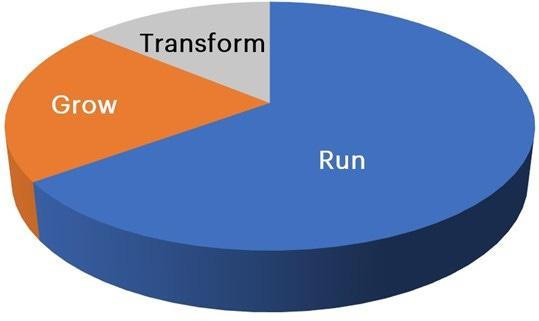
Spend by Cost Category – Figure 1
The first opportunity here is in the creation of a center of excellence comprised of IT, Finance, and Key business operational representatives tasked with ensuring the continuous improvement in the efficiency of IT services. The need for business representation is strategic. It is also an excellent opportunity to solicit their input into the reduction of Run service delivery expectations.
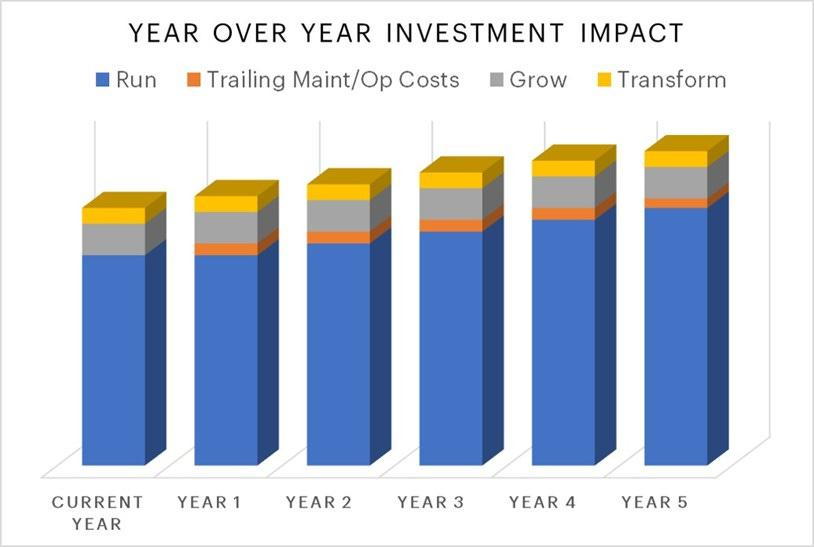
Year over Year Investment Impact on Spend – Figure 2
More importantly, it is an excellent time to educate the business on the operational impact of IT investment decisions. Without this education and attention, trailing maintenance costs increase the run costs of the company by 15-20% year over year, as illustrated in the chart above.
IT Spend by Cost Component
These days, the most substantial portion of IT costs for most organizations is associated with internal staff and outsourcing. Improving cost-effectiveness and enabling cost reductions will require a detailed look at services by category and identification of duplication of services while exploring alternative delivery models.
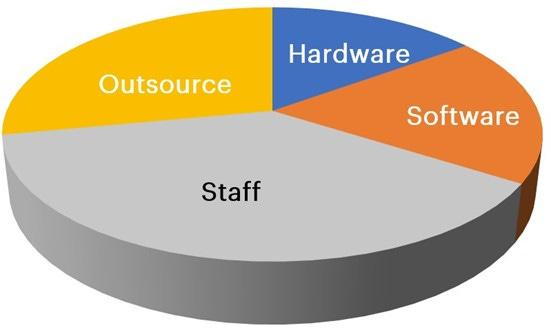
Spend by Cost Category – Figure 3
The opportunity here is to look deep into each cost component to understand the opportunities to optimize, renegotiate, extend, or eliminate contracts or services.
Now is also the time to take a deep look, often for the first time, at the organizational design and staff skills inventory in preparation for a potential call to restructure staff or headcount.
Do you know who your essential team members are and their responsibilities?
IT Spend by Technology Domain
IT spending is spread across a combination of infrastructure, application, service desk, and IT management workload areas.
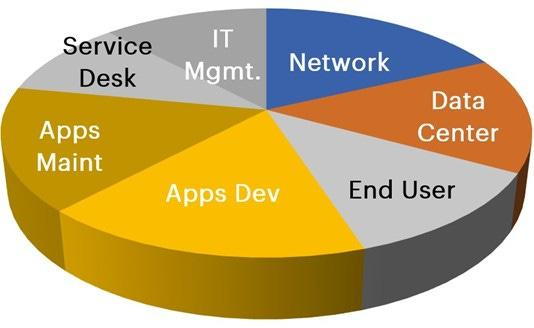
Spend by Domain – Figure 4
Experience shows us that there are always real opportunities for significant cost savings and service improvements in each of these areas. Areas of cost reduction opportunities might include renegotiating service contracts, extending service life, consolidating data centers, or reducing the number of applications.
Next, look for opportunities to control. contain, or cut costs.
Quick cost-saving "WINS": Scrutinize in-flight or planned Grow or Transform initiatives to eliminate or defer anything that does not contribute to immediate cost reductions or profit margin increase.
One-time hard savings (current spending or next budget cycle}: Reduce fixed costs by a set amount in the present or future budget cycle/quarter.
Recurring hard savings (current spending or next budget cycle): Reduce variable costs regularly, proportionate to volume, in the present, or next budget cycle/quarter.
Reduced future costs: Savings on what would have been spent during out years. For example, renegotiating a three to five-year maintenance contract reduces savings in out years, which should be captured and tracked, but don't have the same cash-flow impact as savings in the current or next budget cycle.
Expense deferral: Taking an action that will result in an expense being due and payable at a future date, rather than during the current time period. Many cost optimization efforts make the mistake of not differentiating between putting off a cost into the future and making structural changes that will reduce the long-term run rate.
Staff/Headcount reductions: Reduction in force is never easy and often results in significant lost productivity. Analyze your skills inventory against critical functions and talk in detail. Without this level of scrutiny, staff reductions represent the highest risk of cutting to the bone. It is essential to have a clear understanding of the functions of every team member.
As you list your opportunities for cost-cutting, keep in mind that not all cost-cutting efforts are helpful. There is a downside to attempting the wrong kind of cuts. Some can be quite dangerous to the intended outcome as well as IT's reputation. Here are a few to consider listed in the table below:
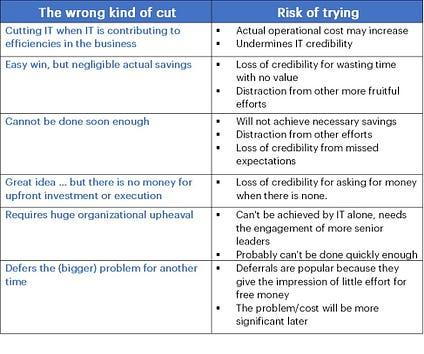
Finally, inform and negotiate cost-cutting targets
Most often, the CEO or CFO dictates reduction IT Cost goals with directives such as "Cut your total cost by X%." This is understood. At the same time, the CIO will demonstrate managerial courage in clearly articulating and informing the business of both the positive and negative impact of that directive. This is where knowing your benchmark position will come in handy when building your story. When opportunities and risks are articulated in clear business terms, the CIO can earn the right to negotiate the goal in partnership with the business leadership.
Last, execute against the plan.
Seriously, this is hard stuff and not the fun technology stuff. By putting extra effort into the analysis, you will be better positioned to manage costs and be prepared for the next time. There is always a next time.
Feel free to contact me with questions we left unanswered.
Until next week! Mary

The technology tide is here. Are you prepared to handle the cost tsunami?
In 2024, the unstoppable tide of workplace modernization and IT automation isn't just a trend - it's a business imperative. This movement, sweeping all corners of the corporate landscape, is ushering in an era synonymous with increased automation, pervasive adoption of cloud-based solutions, and the relentless drive for unique online customer experiences and optimized internal productivity.
What does this mean for the CIO? Businesses are now identifying as technology companies because they recognize the strategic necessity of such a shift. The result is an unprecedented increase in IT spending. According to a Gartner January 17, 2024 Press Release:
"Worldwide IT spending is expected to total $5 trillion in 2024, an increase of 6.8% from 2023, according to the latest forecast by Gartner, Inc. This is down from the previous quarter's forecast of 8% growth."
I also invite you to read the recently published CIO's "State of the CIO, 2023 Building Business Strategy. There has never been a more exciting and challenging opportune time for IT leaders to influence their company's strategy. But then again, I've been saying that for close to 40 years. It only gets better and harder.
What does it mean to the CEO?
Imagine standing at the core of a modern, cutting-edge business. As a CEO, you're aware of the pivotal role technology plays in being competitive and delivering exceptional products and services. You're convinced that strategic investments in IT could propel your business forward. However, you equally value prudence in spending habits and expect your CIOs and IT teams to stay on top of costs.
Does this tightrope walk sound familiar? The answer lies in IT cost management. Essentially, it aids you in strategically planning and controlling tech-related expenses, ensuring your investments pay off rather than tip the budget. It also frees up critical dollars to invest in new technologies.
What does it mean to the CIO?
Why is it critical? Well, in this fast-paced business environment, cost control is the backbone of organizational success, regardless of the industry. In support of the overall corporate cost management remit, CIOs are ever challenged to demonstrate business value while delivering greater services and value.
Level Setting Cost Management Vs Cost Control vs Cost Cutting?
We will start by ensuring a solid understanding of the difference between Cost Management, Cost Control, and Cost-cutting. There is an overlap and correlation.
Cost management is the process of planning and controlling the budget of a business, department of a project, or business. It includes activities such as planning, estimating, budgeting, financing, funding, managing, and controlling costs so that the business period or project can be completed within the approved budget.
Cost management is a continuous process that covers the full life cycle starting with the initial planning phase towards measuring the actual cost and services performance, including project planning and delivery as well as delivery of new capabilities via investment projects and programs.
Whereas, Cost Control is concerned with measuring variances from the cost baseline and taking effective corrective action to ensure minimum cost overruns.
Procedures are applied to monitor expenditures and performance against the progress of a project. All changes to the cost baseline need to be recorded, and the expected final total costs are continuously forecasted.
When actual cost information becomes available, an important part of cost control is to explain what is causing the variance from the cost baseline. Based on this analysis, corrective action might be required to avoid cost overruns. Tight cost control gives a company considerable influence over its cash flow and reported profits.
IT costs are most often a substantial part of a company's operational and capital spending. There are times when external forces drive the need to cut costs for a variety of reasons. One reason may be a change in the market, and another may be due to an acquisition or environmental impacts such as COVID-19. Whatever the reason, the CIO must not only manage costs, but they are also required to deliver core services and cut costs. How would you know which costs can be cut without impacting critical services? Cost Management.
Be it cost management, cost control, or cost cutting, they all require you, the CIO, to be continuously aware of IT's spending to plan while assuring the delivery of promised and expected services AND be ready to pivot as business demands change.
My goal for this article is to provide context as well as a few preliminary steps you can take if the concept of Cost Management is new to you. If you have followed me for a while, you have heard me say, "The CIO has a tough job."
Start with a solid understanding of the current state of IT Spending: How much and in what places.
Let me share an analogy. You need surgery! Can you imagine allowing a surgeon to start cutting without diagnostic tests identifying the root of your health issue? As scary as that concept might be, you must perform the same diagnostics before you begin a cost-cutting initiative.
This first step calls for you to understand the cost of running IT and how your costs compare to your peers and competition. I will leave the benchmarking to benchmarking experts such as Gartner, Infotech, or ISG-One All three have wonderful benchmarking services offerings.
Before you seek benchmarking support, it behooves you to have a clear picture of your spending. There are several KPIs for measuring and assessing your spending. IT spending as a percentage of revenue is a key metric that most organizations use to calculate their IT spending levels.
The formula is simple:
Total IT Operational Spend (including depreciation) / Total Company Revenue
How do you manage or control your budget unless you know the costs and drivers?
I am not talking about the need for a Total Cost of Ownership analysis. I am advocating that you understand your spending from a high level. It is most useful to sort spending into three different views:
IT Spend by Strategic Category
Most IT costs sit in the Run category of spend (average of 65-70% percent of the total budget). Run costs are typically committed contract costs. Unfortunately, we see these costs rising each year unless there has been a continuous program to control run costs. The Grow category focuses on enhancing business processes with new IT-based capabilities, whereas Transform is in support of new business activities.

Spend by Cost Category – Figure 1
The first opportunity here is in the creation of a center of excellence comprised of IT, Finance, and Key business operational representatives tasked with ensuring the continuous improvement in the efficiency of IT services. The need for business representation is strategic. It is also an excellent opportunity to solicit their input into the reduction of Run service delivery expectations.

Year over Year Investment Impact on Spend – Figure 2
More importantly, it is an excellent time to educate the business on the operational impact of IT investment decisions. Without this education and attention, trailing maintenance costs increase the run costs of the company by 15-20% year over year, as illustrated in the chart above.
IT Spend by Cost Component
These days, the most substantial portion of IT costs for most organizations is associated with internal staff and outsourcing. Improving cost-effectiveness and enabling cost reductions will require a detailed look at services by category and identification of duplication of services while exploring alternative delivery models.

Spend by Cost Category – Figure 3
The opportunity here is to look deep into each cost component to understand the opportunities to optimize, renegotiate, extend, or eliminate contracts or services.
Now is also the time to take a deep look, often for the first time, at the organizational design and staff skills inventory in preparation for a potential call to restructure staff or headcount.
Do you know who your essential team members are and their responsibilities?
IT Spend by Technology Domain
IT spending is spread across a combination of infrastructure, application, service desk, and IT management workload areas.

Spend by Domain – Figure 4
Experience shows us that there are always real opportunities for significant cost savings and service improvements in each of these areas. Areas of cost reduction opportunities might include renegotiating service contracts, extending service life, consolidating data centers, or reducing the number of applications.
Next, look for opportunities to control. contain, or cut costs.
Quick cost-saving "WINS": Scrutinize in-flight or planned Grow or Transform initiatives to eliminate or defer anything that does not contribute to immediate cost reductions or profit margin increase.
One-time hard savings (current spending or next budget cycle}: Reduce fixed costs by a set amount in the present or future budget cycle/quarter.
Recurring hard savings (current spending or next budget cycle): Reduce variable costs regularly, proportionate to volume, in the present, or next budget cycle/quarter.
Reduced future costs: Savings on what would have been spent during out years. For example, renegotiating a three to five-year maintenance contract reduces savings in out years, which should be captured and tracked, but don't have the same cash-flow impact as savings in the current or next budget cycle.
Expense deferral: Taking an action that will result in an expense being due and payable at a future date, rather than during the current time period. Many cost optimization efforts make the mistake of not differentiating between putting off a cost into the future and making structural changes that will reduce the long-term run rate.
Staff/Headcount reductions: Reduction in force is never easy and often results in significant lost productivity. Analyze your skills inventory against critical functions and talk in detail. Without this level of scrutiny, staff reductions represent the highest risk of cutting to the bone. It is essential to have a clear understanding of the functions of every team member.
As you list your opportunities for cost-cutting, keep in mind that not all cost-cutting efforts are helpful. There is a downside to attempting the wrong kind of cuts. Some can be quite dangerous to the intended outcome as well as IT's reputation. Here are a few to consider listed in the table below:

Finally, inform and negotiate cost-cutting targets
Most often, the CEO or CFO dictates reduction IT Cost goals with directives such as "Cut your total cost by X%." This is understood. At the same time, the CIO will demonstrate managerial courage in clearly articulating and informing the business of both the positive and negative impact of that directive. This is where knowing your benchmark position will come in handy when building your story. When opportunities and risks are articulated in clear business terms, the CIO can earn the right to negotiate the goal in partnership with the business leadership.
Last, execute against the plan.
Seriously, this is hard stuff and not the fun technology stuff. By putting extra effort into the analysis, you will be better positioned to manage costs and be prepared for the next time. There is always a next time.
Feel free to contact me with questions we left unanswered.
Until next week! Mary





